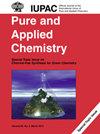Analysis of individual nanoscale block copolymer vesicles by atomic force microscopy combined with time-resolved fluorescence microscopy
IF 2
4区 化学
Q3 CHEMISTRY, MULTIDISCIPLINARY
引用次数: 0
Abstract
We report on the analysis of individual dye loaded block copolymer (BCP) vesicles via a combination of confocal laser scanning microscopy (CSLM)/fluorescence lifetime imaging microscopy (FLIM) on the one hand and atomic force microscopy (AFM) on the other hand. AFM measurements on ATTO 647N-loaded poly(styrene-用原子力显微镜结合时间分辨荧光显微镜分析单个纳米级嵌段共聚物囊泡
我们报告了一方面通过共焦激光扫描显微镜(CSLM)/荧光寿命成像显微镜(FLIM),另一方面通过原子力显微镜(AFM)对单个负载染料的嵌段共聚物(BCP)囊泡进行分析的结果。原子力显微镜对负载 ATTO 647N 的聚(苯乙烯-块状-聚(丙烯酸))(PS115-b-PAA15)囊泡进行了高空间分辨率的测量,并提供了固体基底上 BCP 囊泡的形态和尺寸。相比之下,CSLM 和 FLIM 数据受衍射限制,但从时间分辨荧光数据中可以提取报告染料局部附近的信息。在综合实验中,可以分辨出单个负载染料的囊泡和囊泡聚集体,用原子力显微镜进行计量分析,并用 CSLM 和 FLIM 进行更详细的分析。根据 FLIM 数据分析了报告染料的分配情况。染料优先驻留在囊泡内部的亲水性冠层中。聚合体中的染料浓度比用于封装的溶液高出约 90 倍。这些结果表明,将原子力显微镜与灵敏的光学技术(尤其是 FLIM)相结合,是深入了解超分子大分子结构及其他结构中分子相互作用和纳米环境的一种很有前途的方法。
本文章由计算机程序翻译,如有差异,请以英文原文为准。
求助全文
约1分钟内获得全文
求助全文
来源期刊

Pure and Applied Chemistry
化学-化学综合
CiteScore
4.00
自引率
0.00%
发文量
60
审稿时长
3-8 weeks
期刊介绍:
Pure and Applied Chemistry is the official monthly Journal of IUPAC, with responsibility for publishing works arising from those international scientific events and projects that are sponsored and undertaken by the Union. The policy is to publish highly topical and credible works at the forefront of all aspects of pure and applied chemistry, and the attendant goal is to promote widespread acceptance of the Journal as an authoritative and indispensable holding in academic and institutional libraries.
 求助内容:
求助内容: 应助结果提醒方式:
应助结果提醒方式:


